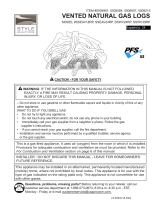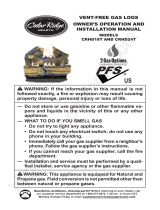
www.desatech.com
901268-01H 3
9. Do not use a blower insert, heat exchang-
er insert or other accessory not approved
for use with this log set.
10.
The installation and provisions for com-
bustion and ventilation air must conform
with the National Fuel Gas Codes, ANSI
Z233.1/NFPA 54, Air for Combustion and
Ventilation.
11. Do not run log set
• where combustible materials, gasoline
and other ammable vapors and liquids
are used or stored
• under dusty conditions
12. Do not burn solid fuel in the replace after
installing the log set. Do not use this log
set to cook food or burn paper or other
objects.
13. Log set becomes very hot when in use.
Keep children and adults away from hot
surface to avoid burns or clothing ignition.
Log set will remain hot for a time after
shut-down. Allow surface to cool before
touching.
14. Carefully supervise young children when
they are in the room with log set.
15. Do not use this appliance if any part has
been under water. Immediately call a
qualied service technician to inspect the
appliance and to replace any part of the
control system and any gas control which
has been under water.
16. To help prevent breakage, new logs must
be broken-in (see Curing Logs, page 11).
17. Turn log set off and let cool before servic-
ing, installing, or repairing. Only a qualied
service person should install, service, or
repair log set.
18. Provide adequate clearances around air
openings.
19. Control knob may be hot when turning
unit off. A 6" extension rod is available
to make the knob more easily accessible
and reduce temperature of control knob
(see Accessories on page 20).
1. This appliance, as supplied, is only for
use with the type of gas indicated on the
rating plate. This appliance is convertible
for use with propane/LP.
2. If you smell gas
• shut off gas supply
• do not try to light any appliance
• do not touch any electrical switch; do not
use any phone in your building
• immediately call your gas supplier from
a neighbor’s phone. Follow the gas
supplier’s instructions
• if you cannot reach your gas supplier,
call the re department
3. Never install the log set
• in a recreational vehicle
• where curtains, furniture, clothing, or
other ammable objects are less than
42" from the front, top, or sides of the
log set
• in high trafc areas
• in windy or drafty areas
4. Before installing in a solid fuel burning re-
place, the chimney ue and rebox must
be cleaned of soot, creosote, ashes and
loose paint by a qualied chimney cleaner.
Creosote will ignite if highly heated. In-
spect chimney ue for damage.
5. You must operate this log set with replace
doors or screens in place and fully closed.
Unless provided by other means, replace
doors or screens shall have openings for
introduction of combustion air.
6. This log set is designed to be smokeless.
If logs ever appear to smoke, turn off appli-
ance and call a qualied service person.
Note: During initial operation, slight smok-
ing could occur due to log curing and
the burning of manufacturing residues.
You may wish to add more ventilation by
opening a window.
7. To reduce the creation of soot, follow the
instructions in Cleaning and Maintenance,
page 12.
8. Do not allow fans to blow directly into the
replace. Avoid any drafts that alter burner
ame patterns. Ceiling fans can create
drafts that alter burner ame patterns.
Altered burner patterns can increase
sooting.
SAFETy
Continued






















